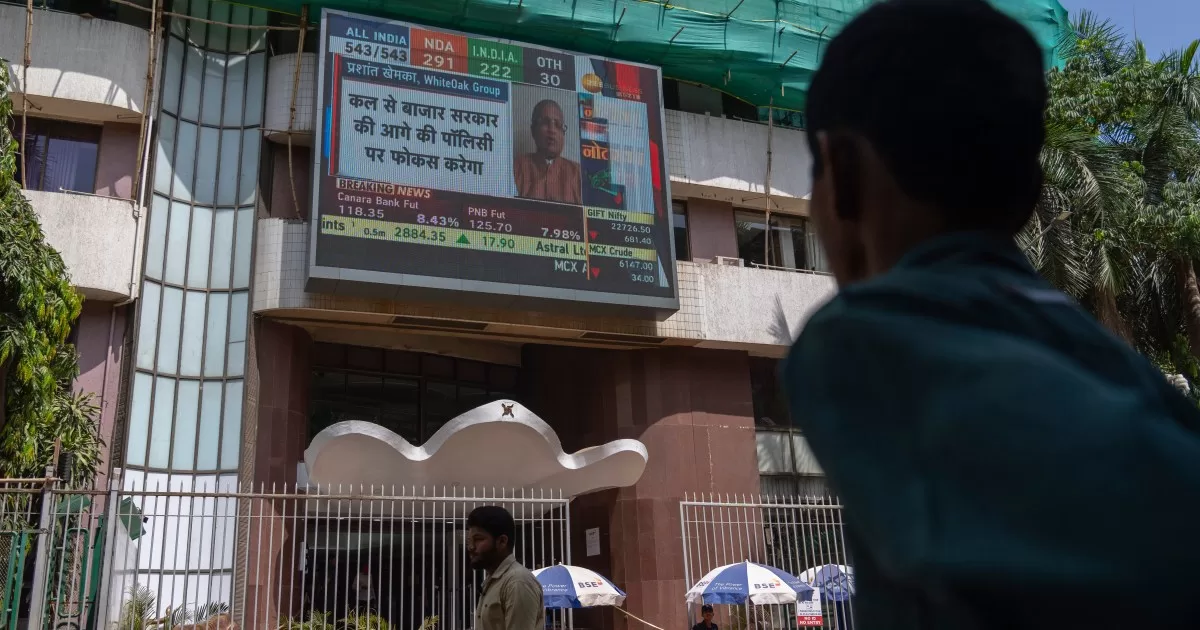The shock outcome of Tuesday’s election count means Modi will need to rely on smaller parties to form a governing majority in the 543-member Lok Sabha, the lower house of India’s parliament, raising uncertainty about the Indian leader’s ability to pursue his pro-business agenda.
The NSE Nifty 50 and BSE Sensex indexes closed at 5.93 percent and 5.74 percent lower, respectively, on Tuesday, after falling by as much as 8.5 percent earlier in the day.
Indian stocks recorded further losses on Wednesday morning before recovering in the afternoon, with the two indexes each up more than 1.5 percent as of 05:30 GMT.
Why have investors reacted negatively to the election result?
Investors have been overwhelmingly favourable towards Modi’s economic agenda throughout his decade-long tenure.
Pledging to transform India into a developed nation by 2047, Modi has directed massive investment into infrastructure, championed domestic manufacturing, lured foreign investment, cut red tape and promised to root out corruption.
On the Indian leader’s watch, the Nifty 50 index has almost tripled in value – although some analysts argue that many Indian firms are now overvalued.
Earlier this year, India’s stock market capitalisation topped $4.3 trillion to overtake Hong Kong as the world’s fourth-largest market.
Before Tuesday’s surprise election outcome, Indian stocks surged to record highs as exit polls showed the BJP-led National Democratic Alliance (NDA) on track for a landslide victory.
Modi, a popular but polarising leader, has presided over a period of strong economic growth in the world’s most populous nation.
Gross domestic product (GDP) grew by 8.2 percent in the fiscal year ending in April, far outpacing most developing and developed economies alike.
Over the last decade, the GDP per capita has risen from about $5,000 to more than $7,500.
During that time, India has gone from being the ninth-largest economy in the world to the fifth-largest.
While Modi has all but secured a third term as prime minister, his need to negotiate with smaller constituents of his coalition raises the possibility that he will have to compromise on aspects of his economic agenda.
“A very high majority for BJP-led NDA would have meant greater appetite for reforms and limited need for any populist measures, and continued capital expenditure agenda,” Garima Kapoor, an economist and a senior vice president at Elara Capital in New Delhi, told Al Jazeera.
“The markets are reassessing this shift and hence, most public sector units, public sector banks and capital expenditure-led stocks are seeing sharp correction.”
Alexandra Hermann, a senior economist at Oxford Economics, said Modi’s smaller-than-expected majority would make it more difficult to pass reforms related to land, labour and capital regulations.
“Further – less contentious – infrastructure investment will likely remain a key focus,” Hermann told Al Jazeera.
Perhaps more than anything else, though, markets hate uncertainty – a dynamic delivered by Tuesday’s unemphatic outcome.
How will the election affect India’s economic policies?
Many of India’s economic advantages are unaffected by the election outcome, or even who is in power.
Whatever direction Modi’s coalition takes, the country will still benefit from a huge relatively young population.
New Delhi, which has traditionally had a policy of non-alignment, is also likely to keep benefitting from its distance from the geopolitical rivalry between the United States and its allies on the one side and Russia and China on the other.
“We do not think the election outcome affects the longer-term outlook of the India market, which is underpinned by longer-term tailwinds of favourable population demographics and the extended geopolitical tensions between China and US favouring a shift to India,” Gary Tan, a portfolio manager at Allspring Global Investments, told Al Jazeera.
Kapoor of Elara Capital said that she did not believe the election result would lead to much of a shift in policy over the longer term.
“In the long run, NDA at 290 or 310 doesn’t mean much difference in terms of policy approach. Overall, the shift is mainly in terms of whether we see aggressive supply-side reforms or see a balance between supply-side and demand-side reforms,” she said.
Is India’s stock market boom going to last?
Despite India’s impressive GDP growth, the country’s economy faces serious challenges, including widespread poverty, growing inequality, and pervasive corruption.
Among the most pressing issues is a shortage of quality jobs to match the needs of its huge population.
In a report released earlier this year, the International Labour Organization warned of a “mismatch” between the aspirations of India’s educated youth and available jobs.
“Beyond a narrow view of the unemployed, there is a large proportion of youths, particularly young women, not in education, employment or training,” the UN body said.
Tan said that India’s growing household debt is another concern.
“The Reserve Bank of India has been stepping in to control this risk. While positive for a more sustainable growth path, the near-term cost can result in slower credit growth at an important juncture in India where private corporate capital expenditure is looking to play catch-up from previous years of underinvestment alongside the rolling out of large-scale infrastructure projects,” he said.
After years of rip-roaring gains, some analysts believe that many Indian firms are now overvalued, in part due to a huge influx of inexperienced small-time local investors into the market.
In an analysis last month, financial services firm Morning Star quoted a portfolio manager who noted that Indian stocks were trading at higher prices than other emerging markets.
“We remain selective in the companies we invest in and favour those that have sustainable earnings power and whose share prices are at a discount to our estimate of their intrinsic value,” Morning Star quoted Chetan Sehgal of Franklin Templeton as saying.
